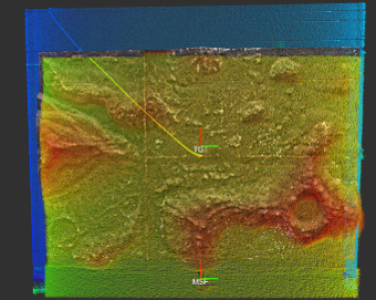De-risk assessment: Compact Scanning LiDAR

The main technical objective of this project phase is to demonstrate that a LiDAR with path-to-flight is physically viable with an spatial light modulator (SLM) that can steer a beam at 1kHz. There are 2 main parallel objectives, MDA UK will develop a control system able to address a several hundred pixel device and benchmark it on a flight processor. The University of Oxford will upgrade a single pixel distributed device into a multi-pixel large-scale integrated device to show that light phase can be modulated at 1kHz simultaneously in order to beamform.
Laser-focused resolution and the ability to work without background illumination favour the use of Light Detection and Ranging (LiDAR) in a vast range of space applications. However, LiDAR technology is not without shortcomings, such as its significant Mass, Volume and Power (MVP) budgets, as well as development time. Modern mission parameters are pushing the Space market towards more compact, less costly solutions. LiDAR as it exists today does not meet these requirements, in large part due to the presence of mechanically-driven laser beam-steering components. The Compact Scanning LiDAR (COLD) could allow a 70% reduction in MVP, as well as ultimately improving overall performance and reliability. This would enable LiDAR on CubeSat platforms.
COLD simulator developed allowing for early technology de-risk and understanding of technical trade-offs. Lidar subsystem controls developed in FPGA with path-to-flight target. A singe pixel device optical characteristics have been successfully tested and a fabrication process has been determined to simplify the integration of a multi-pixel SLM from a single glass cell filled with liquid crystal. Resulting multi-pixel device integrated and tested to show optical properties match single pixel device. LIDAR FPGA VHDL integrated and synthesized + laid out to show full LIDAR with SLM control can be done with a path to flight processor.
The results show the main risks of pursuing a programme to develop space LiDAR using SLM are being mitigated. Space hardware should be able to control several hundred pixels at 1kHz rate and the SLM should be possible using the emerging liquid crystal technology. This paves the way for a space-qualified SLM LiDAR capable of fitting on a CubeSat or light roving platform, enhancing current LiDAR applications for new-space.
The next step is to build on design selected during de-risk phase to deliver the design requirements and an initially hardware integrated breadboard (target Q2 2021), then integrate the LiDAR with a commercial SLM to create a Development Model (target Q3 2022) while developing a nano-scale SLM device, then integrate the nano-scale device into an Engineering Model (target Q4 2023), then qualify Qualification Model for flight and deliver Flight Model (target Q2 2025). MDA UK is working to secure GSTP funding for follow-on activities to target satellite servicing activities for commercial customers, as well as ESA safe space (orbital debris removal, planetary protection) and Lunar and Mars exploration missions.
